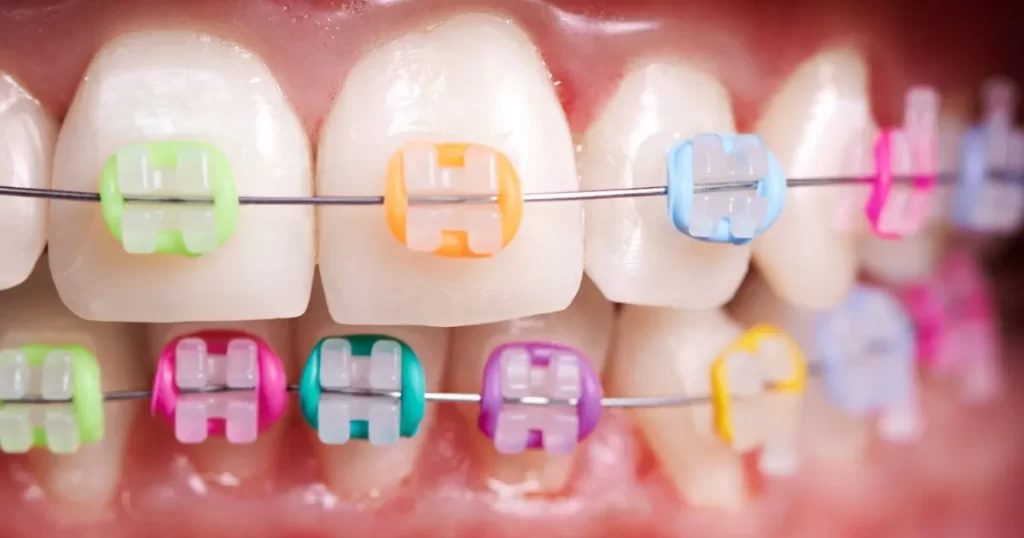Ceramic Braces
- Home
- Dental Braces
- Ceramic Braces
Ceramic braces are a type of orthodontic treatment that uses clear or tooth-colored brackets to straighten teeth. They are a popular alternative to traditional metal braces for people who want a more discreet treatment option. In this article, we will explore the benefits and drawbacks of ceramic braces, how they work, and what to expect during treatment.

Ceramic braces are similar to traditional metal braces in terms of how they work, but they are made with clear or tooth-colored brackets instead of metal. These brackets are attached to the teeth with dental adhesive, and a thin wire is threaded through them to apply pressure and gradually move the teeth into the correct position.
There are two types of ceramic braces: clear and tooth-colored. Clear ceramic braces are made with a transparent material that blends in with the natural color of your teeth, making them less noticeable than metal braces. Tooth-colored ceramic braces are made with a material that matches the color of your teeth, making them even more discreet.
Discreet: Ceramic braces are a more discreet option than traditional metal braces because the brackets are clear or tooth-colored and blend in with your teeth.
Effective: Ceramic braces are just as effective as metal braces at straightening teeth and correcting bite issues.
Comfortable: Ceramic braces are more comfortable than traditional metal braces because the brackets are smoother and less likely to irritate your gums and cheeks.
Stain-resistant: The ceramic material used in these braces is stain-resistant, which means they will not discolor over time.
- Colorful: You can customize the bands used with colors
Cost: Ceramic braces are more expensive than traditional metal braces because of the materials used.
Durability: Ceramic braces are more fragile than metal braces and can chip or break if not cared for properly.
Treatment Time: Treatment with ceramic braces may take longer than with metal braces because the ceramic material is not as strong as metal.
Oral Hygiene: Proper oral hygiene is essential during orthodontic treatment, especially when it comes to ceramic braces. You will need to brush and floss your teeth regularly to prevent plaque buildup and keep your braces and teeth clean.
Ceramic braces work in a similar way to traditional metal braces. The brackets are attached to the teeth using a special adhesive, and an archwire is threaded through the brackets to apply pressure to the teeth. Over time, this pressure gradually moves the teeth into the correct position.
During treatment, patients will need to visit their orthodontist regularly for adjustments. At these appointments, the orthodontist will tighten the archwire to apply more pressure to the teeth, gradually moving them into the correct position.
Here are some things to expect during treatment with ceramic braces:
Initial Consultation: Your orthodontist will examine your teeth and take X-rays to determine if ceramic braces are the right treatment option for you.
Bracket Placement: Once you have decided to proceed with ceramic braces, your orthodontist will attach the brackets to your teeth using a special adhesive. This process is typically painless and takes about an hour.
Adjustments: You will need to visit your orthodontist regularly for adjustments throughout your treatment. During these appointments, the orthodontist will tighten the archwire to apply more pressure to your teeth, gradually moving them into the correct position.
Oral Hygiene: Proper oral hygiene is essential during orthodontic treatment, especially when it comes to ceramic braces. You will need to brush and floss your teeth regularly to prevent plaque buildup and keep your braces and teeth clean.
Diet Restrictions: During treatment, you will need to avoid certain foods that can damage your braces or make it harder to keep your teeth clean. These include hard, sticky, or chewy foods.
Discomfort: It is normal to experience some discomfort during the first few days after getting ceramic braces and after each adjustment. This discomfort can be managed with over-the-counter pain medication and will usually subside within a few days.
Treatment Completion: Once your teeth have been moved into the correct position, your orthodontist will remove your ceramic braces. You will then be given a retainer to wear to help keep your teeth in their new position.
Ceramic braces are a great option for many patients, but they may not be the right choice for everyone. Here are some factors to consider when determining if ceramic braces are a good fit for you:
Appearance: If you are concerned about the appearance of traditional metal braces, ceramic braces may be a good option for you.
Dental Problems: Ceramic braces are just as effective as metal braces when it comes to correcting dental problems such as crooked teeth, gaps, and bite issues.
Lifestyle: Ceramic braces require a certain level of commitment, including regular visits to the orthodontist, proper oral hygiene, and diet restrictions. If you are willing to make these commitments, ceramic braces may be a good choice for you.
Budget: Ceramic braces can be more expensive than traditional metal braces, so it’s important to consider your budget when deciding on a treatment option.
Age: Ceramic braces are a good option for patients of all ages, but they may be particularly appealing to adults who are looking for a more discreet treatment option.
Proper care of your ceramic braces is essential for ensuring the best possible results and avoiding any complications. Here are some tips for caring for your ceramic braces:
Brush and floss regularly: Brush and floss your teeth at least twice a day to prevent plaque buildup and keep your braces and teeth clean.
Avoid certain foods: Hard, sticky, or chewy foods can damage your braces or make it harder to keep your teeth clean. Avoid these foods during treatment.
Attend regular appointments: Regular visits to your orthodontist are essential for ensuring that your treatment is progressing as planned.
Use a fluoride mouthwash: A fluoride mouthwash can help strengthen your teeth and prevent cavities during orthodontic treatment.
Wear a mouthguard: If you play sports or engage in other physical activities, wearing a mouthguard can help protect your braces and teeth from damage.
Ceramic braces are a popular alternative to traditional metal braces for patients who are looking for a more discreet orthodontic treatment option. They are just as effective as metal braces and offer several benefits, including improved appearance and increased comfort. If you are interested in ceramic braces, talk to your orthodontist to determine if they are the right treatment option for you. With proper care and regular visits to your orthodontist, you can achieve a beautiful, healthy smile with ceramic braces.

